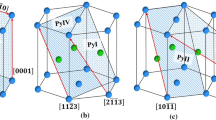Abstract
A continuum model is proposed to study the effects of deformation twinning on interface crack kinking in metal/ceramics layered materials. At the final stage of material failure, plastic work hardening exhausts and lattice rotation becomes main mechanism after competing with dislocation gliding. The crack-tip plasticity is established in terms of the second gradient of microrotation due to the coupling effect of the twins. The formed twinning structures not only shield the crack tip, but inhibit further dislocation emission by increasing the near-tip stress levels. A Dislocation-Free Zone (DFZ) can exist in the immediate vicinity of the tip. The model is based on the equivalence of the stresses derived from twin-based crack-tip plasticity, macroscopic plasticity and elasticity on the boundary. The two-parameter characterization of near-tip stress fields is used for the outer plastic zone to account for constraint effects. Crack kinking out of the interface follows the direction of the maximum flow stress from the crack-tip plasticity. The DFZ size and the crack-tip shielding ratio, as well as the kink angle, are obtained for various values of low hardening exponents and crack-tip constraints.
Similar content being viewed by others
References
Allian S, Chateau J-P, Bouaziz O (2004) A physical model of the twinning-induced plasticity effect in a high manganese austenitic steel. Mater Sci Eng A 387—389: 143–147. doi:10.1016/j.msea.2004.01.060
Beltz GE, Rice JR, Shih CF, Xia L (1996) A self-consistent model for cleavage in the presence of plastic flow. Acta Mater 44: 3943–3954. doi:10.1016/S1359-6454(96)00047-X
Blewitt TH, Coltman RR, Redman JK (1957) Low-temperature deformation of cooper single crystals. J Appl Phys 28: 651–660. doi:10.1063/1.1722824
Brechet Y, Canova G, Kubin LP (1996) Strain softening, slip localization and propagation: from simulation to continuum modelling. Acta Mater 44: 4261–4271. doi:10.1016/1359-6454(96)00115-2
Chen Q, Huang Y, Qiao L, Chu W (1999) Failure modes after exhaustion of dislocation glide ability in thin crystals. Sci China Ser E 42: 1. doi:10.1007/BF02876851
Christian JW, Mahajan S (1995) Deformation twinning. Prog Mater Sci 39:1–157. doi: 10.1016/0079-6425(94)00007-7
Farkas D, Duranduru M, Curtin WA, Ribbens C (2001) Multiple-dislocation emission from the crack tip in the fuctile fracture of Al. Phil Mag 81: 1241
Hai S, Tadmor EB (2003) Deformation twinning at aluminium crack tips. Acta Mater 51: 117–131. doi:10.1016/S1359-6454(02)00367-1
Hancock JW, Reuter WG, Parks DM (1993) Constraint effects in fracture. ASTM STP 1171: 21–40
Hutchinson JW (1968) Singular behaviour at the end of a tensile crack in a hardening material. J Mech Phys Solids 16:13–31. doi:10.1016/0022-5096(68)90014-8
Hutchinson JW, Suo Z (1991) Mixed mode cracking in layered materials. Adv Appl Mech 29: 63–191
Kysar JW (2003) Energy dissipation mechanisms in ductile fracture. J Mech Phys Solids 51: 793–824
Kysar JW, Briant CL (2002) Crack tip deformation fields in ductile single crystals. Acta Mater 50: 2367–2380
Lipkin DM, Clark DR, Beltz GE (1996) A strain-gradient model of cleavage fracture in plastically deforming materials. Acta Mater 44: 4051–4058
Nakatani A, Drugan WJ, van der Giessen E, Needleman A (2003) Crack tip fields at a ductile single crystal-rigid material interface. Int J Fract 122: 131–159
Narita N, Takamura J (1992) In Dislocations in solids, No. 9, Nabarro FRN (ed) North-Holland, Amsterdam, p 154
O’Dowd NP, Shih CF (1991) Family of crack-tip fields characterised by a triaxiality parameter—I. Structure of fields. J Mech Phys Solids 39: 989–1015
Ohr SM, Chuang SJ (1982) Dislocation-free zone model of fracture comparison with experiments. J Appl Phys 53: 5645
Press WH, Flannery BP, Teukolsky SA, Vetterling WT (1992) Numerical recipes. Cambridge University Press, Cambridge
Pond RC, Garcia-Garcis LMF (1981) Deformation twinning in aluminium. Inst Phys Conf Ser 61: 495
Rice JR (1987) Tensile crack tip fields in elastic-ideally plastic crystals. Mech Mater 6: 317
Romanov AE (2003) Importance of disclinations in severe plastically deformed materials. Adv Eng Mater 5: 301
Romanov AE, Vladimirov VI (1992) Disclinations in crystalline solids. In: Nabarro FRN (ed) Dislocations in solids, No. 9. North-Holland, Amsterdam, p 191
Saeedvafa M, Rice JR (1989) Crack tip singular fields in ductile crystals with Taylor power-law hardening. II: plane strain. J Mech Phys Solids 37: 673
Saka H, Agata Y (2003) Direct evidence of dislocation free zone in Fe-5%Si fractured by Charpy impact test. Mater Sci Eng A 350: 57–62
Shih CF, Asaro A (1988) Elastic–Plastic analysis of cracks on bimaterial interfaces: part I—Small-scale yielding. J Appl Mech 55: 299–316
Smida T, Bosansky J (2002) Fracture mode transition phenomena in steels as a consequence of the change of operating deformation mode. Mater Sci Eng A 323: 21
Suo Z, Shih CF, Varias AG (1993) A theory for cleavage cracking in the presence of plastic flow. Acta Metall Mater 41: 1551–1557
Tvergaard V (1999) Effect on cleavage crack growth resistance at an interface. J Mech Phys Solids 47: 1095–1112
Wang TC (1990) Elastic–plastic asymptotic fields for cracks on bimaterial interfaces. Eng Fract Mech 37: 527
Zhang X (2008) A continuum model of deformation-twin dominant crack growth in fcc metals. Philos Mag Lett 88: 55–65
Author information
Authors and Affiliations
Corresponding author
Rights and permissions
About this article
Cite this article
Zhang, X. A model on twinning-induced crack kinking out of a metal-ceramics interface. Int J Fract 152, 27–35 (2008). https://doi.org/10.1007/s10704-008-9263-x
Received:
Accepted:
Published:
Issue Date:
DOI: https://doi.org/10.1007/s10704-008-9263-x




